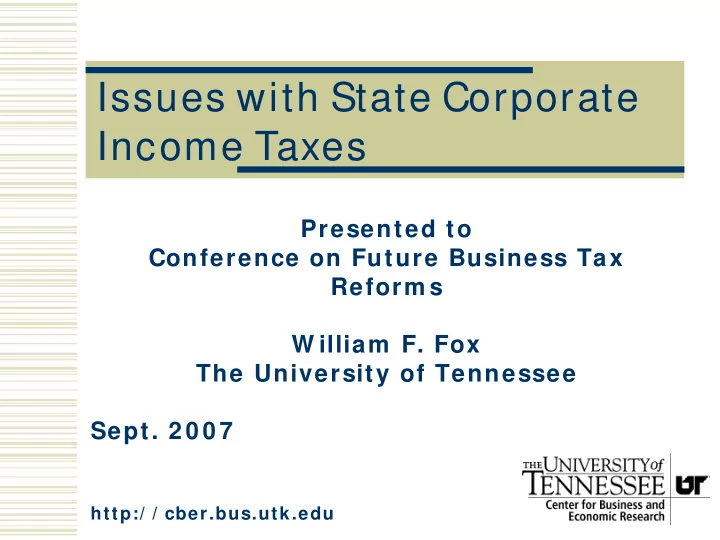

Issues with State Corporate Income Taxes Presented to Conference on Future Business Tax Reform s W illiam F. Fox The University of Tennessee Sept. 2 0 0 7 http:/ / cber.bus.utk.edu
Some Alternatives for Taxing Business � Corporate Income Tax � Corporate Franchise Tax � Value Added Tax – Michigan, New Hampshire; Many economists prefer an origin VAT as the mechanism for state business taxation � Texas Margins Tax � Gross Receipts Taxes – Ohio, New Jersey, Kentucky, Washington September 2007 William F. Fox, Center for Business and Economic Research, http://cber.bus.utk.edu 2
I. PE PE RCE RCE NTAGE NTAGE DISTRIBUTION OF U.S. STATE DISTRIBUTION OF U.S. STATE TAX COLLE TAX COLLE CTIONS, 2006 CTIONS, 2006 Property Other 1.7% 10.3% Corporate Income 6.7% General Sales 32.1% Individual Selective Income Sales 34.6% 14.7% September 2007 William F. Fox, Center for Business and Economic Research, http://cber.bus.utk.edu 3
Businesses Pay Many Taxes, FY2006 Individual Sales Tax on 3.9% Business Inputs Business 22.5% Property 37.0% Excise & Gross Receipts 11.7% Corporate Corporate Franchise & Income Other Payroll 9.4% Business 7.5% 8.9% Ernst & Young, 2007 September 2007 William F. Fox, Center for Business and Economic Research, http://cber.bus.utk.edu 4
State Corporate Income Tax Rates No corporate income tax 4.0% - 6.5% 6.6% - 7.5% 7.6% - 10.0 % 12.0% Michigan imposes a single business tax of 1.9% on the sum of federal taxable income of the business, compensation paid to employees, dividends, interest, royalties paid and other items. Texas imposes a franchise tax of 4.5% of earned surplus of 2.5 mils of net worth. September 2007 William F. Fox, Center for Business and Economic Research, http://cber.bus.utk.edu 5 Source: Federation of Tax Administrators, March 2005.
State Corporation Net Income and License Tax Base 8.0 0.60 7.0 0.50 6.0 Percent of Corporate Profits 0.40 5.0 Percent of GDP 4.0 0.30 3.0 As a Percent of Corporate Profits 0.20 As a Percent of GDP 2.0 0.10 1.0 0.0 0.00 79 80 81 82 83 84 85 86 87 88 89 90 91 92 93 94 95 96 97 98 99 00 01 02 03 04 05 6 September 2007 William F. Fox, Center for Business and Economic Research, http://cber.bus.utk.edu 6
Why has the corporate income tax base been shrinking? � State policy decisions � Concessions � Greater weight on sales factor? � Federal policy decisions � Accelerated depreciation � Production exemptions � Tax planning � Transfer pricing and intangible holding companies � Corporate structure September 2007 William F. Fox, Center for Business and Economic Research, http://cber.bus.utk.edu 7
State Approaches to Tax Planning and Entity Isolation � Combined reporting � Disallow deductions between related companies - Massachusetts � Impose nexus on passive investment companies – South Carolina � Examine PIC for valid business purposes - Maryland � Audit transfer prices � All will be incomplete September 2007 William F. Fox, Center for Business and Economic Research, http://cber.bus.utk.edu 8
Other Business Taxes � Could argue for eliminating business taxes, but unless that occurs, the alternative base taxes may be best evaluated in the context of what they replace – generally the corporate income tax � Well understood that gross receipts taxes are not effective tax instruments, but most discussions evaluate gross receipts taxes in context of a theoretically pure tax rather than the tax they are likely to replace � Corporate income tax can be thought of as three taxes � Payroll � Property � Sales � As move to greater sales weighting, the corporate income tax is a tax on gross receipts with the rate dependent on the profitability of the firm. September 2007 William F. Fox, Center for Business and Economic Research, http://cber.bus.utk.edu 9
Comparison of CIT and GRT � Taxpayers � Unincorporated businesses � No PL86-272 constraint � Unprofitable firms � Evasion/avoidance options – � Easier for CIT � Effects of marginal rate depends on profitability of company September 2007 William F. Fox, Center for Business and Economic Research, http://cber.bus.utk.edu 10
Comparison of CIT and GRT � Total tax liability depends on number of stages of production � Which causes greater distortions, a 6.5% corporate income tax or a 1.0% gross receipts tax � Distorts equity - cascading � Encourages vertical integration � Hurts transparency, but CIT? � Differential burdens across firms � GRT likely to be larger burden for low margin firms – differential effective rate by industry, but also true to some extent with the CIT September 2007 William F. Fox, Center for Business and Economic Research, http://cber.bus.utk.edu 11
Comparison of CIT and GRT � Administrative issues � Transition costs � GRT is an above the line tax � Issues of nexus and sourcing remain � Complexity rises if both an income and alternative tax must be calculated, but otherwise probably not � Revenue Implications � GRT base is generally very broad, and can be expected to exceed gross product � Sizeable revenue potential, even with low rates (0.23% in Ohio) � More stable than the corporate income tax September 2007 William F. Fox, Center for Business and Economic Research, http://cber.bus.utk.edu 12
September 2007 William F. Fox, Center for Business and Economic Research, http://cber.bus.utk.edu 13
Recommend
More recommend